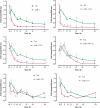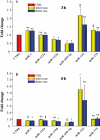Circulating microRNAs are new and sensitive biomarkers of myocardial infarction
- PMID: 20534597
- PMCID: PMC2980809
- DOI: 10.1093/eurheartj/ehq167
Circulating microRNAs are new and sensitive biomarkers of myocardial infarction
Abstract
Aims: Circulating microRNAs (miRNAs) may represent a novel class of biomarkers; therefore, we examined whether acute myocardial infarction (MI) modulates miRNAs plasma levels in humans and mice.
Methods and results: Healthy donors (n = 17) and patients (n = 33) with acute ST-segment elevation MI (STEMI) were evaluated. In one cohort (n = 25), the first plasma sample was obtained 517 ± 309 min after the onset of MI symptoms and after coronary reperfusion with percutaneous coronary intervention (PCI); miR-1, -133a, -133b, and -499-5p were ~15- to 140-fold control, whereas miR-122 and -375 were ~87-90% lower than control; 5 days later, miR-1, -133a, -133b, -499-5p, and -375 were back to baseline, whereas miR-122 remained lower than control through Day 30. In additional patients (n = 8; four treated with thrombolysis and four with PCI), miRNAs and troponin I (TnI) were quantified simultaneously starting 156 ± 72 min after the onset of symptoms and at different times thereafter. Peak miR-1, -133a, and -133b expression and TnI level occurred at a similar time, whereas miR-499-5p exhibited a slower time course. In mice, miRNAs plasma levels and TnI were measured 15 min after coronary ligation and at different times thereafter. The behaviour of miR-1, -133a, -133b, and -499-5p was similar to STEMI patients; further, reciprocal changes in the expression levels of these miRNAs were found in cardiac tissue 3-6 h after coronary ligation. In contrast, miR-122 and -375 exhibited minor changes and no significant modulation. In mice with acute hind-limb ischaemia, there was no increase in the plasma level of the above miRNAs.
Conclusion: Acute MI up-regulated miR-1, -133a, -133b, and -499-5p plasma levels, both in humans and mice, whereas miR-122 and -375 were lower than control only in STEMI patients. These miRNAs represent novel biomarkers of cardiac damage.
Figures





Comment in
-
Circulating microRNAs: novel biomarkers for cardiovascular diseases?Eur Heart J. 2010 Nov;31(22):2705-7. doi: 10.1093/eurheartj/ehq221. Epub 2010 Jul 6. Eur Heart J. 2010. PMID: 20605798 No abstract available.
Similar articles
-
A signature of circulating microRNAs differentiates takotsubo cardiomyopathy from acute myocardial infarction.Eur Heart J. 2014 Apr;35(15):999-1006. doi: 10.1093/eurheartj/eht392. Epub 2013 Sep 17. Eur Heart J. 2014. PMID: 24046434 Free PMC article.
-
Expression of circulating microRNAs in patients with ST segment elevation acute myocardial infarction.Minerva Cardioangiol. 2015 Oct;63(5):397-402. Epub 2015 Jul 22. Minerva Cardioangiol. 2015. PMID: 26198874
-
Circulating miR-122-5p/miR-133b Ratio Is a Specific Early Prognostic Biomarker in Acute Myocardial Infarction.Circ J. 2016 Sep 23;80(10):2183-91. doi: 10.1253/circj.CJ-16-0568. Epub 2016 Sep 2. Circ J. 2016. PMID: 27593229 Clinical Trial.
-
Comparison of the Clinical Value of miRNAs and Conventional Biomarkers in AMI: A Systematic Review.Front Genet. 2021 Jun 17;12:668324. doi: 10.3389/fgene.2021.668324. eCollection 2021. Front Genet. 2021. PMID: 34220945 Free PMC article.
-
Current Knowledge of MicroRNAs (miRNAs) in Acute Coronary Syndrome (ACS): ST-Elevation Myocardial Infarction (STEMI).Life (Basel). 2021 Oct 8;11(10):1057. doi: 10.3390/life11101057. Life (Basel). 2021. PMID: 34685428 Free PMC article. Review.
Cited by
-
Circulating microRNAs involved in multiple sclerosis.Mol Biol Rep. 2012 May;39(5):6219-25. doi: 10.1007/s11033-011-1441-7. Epub 2012 Jan 10. Mol Biol Rep. 2012. PMID: 22231906
-
On the epigenetics of vascular regulation and disease.Clin Epigenetics. 2012 May 23;4(1):7. doi: 10.1186/1868-7083-4-7. Clin Epigenetics. 2012. PMID: 22621747 Free PMC article.
-
The emerging role of microRNAs in hypoxia-induced pulmonary hypertension.Sleep Breath. 2016 Sep;20(3):1059-67. doi: 10.1007/s11325-016-1351-y. Epub 2016 May 7. Sleep Breath. 2016. PMID: 27154628 Review.
-
Normalization of circulating microRNA expression data obtained by quantitative real-time RT-PCR.Brief Bioinform. 2016 Mar;17(2):204-12. doi: 10.1093/bib/bbv056. Epub 2015 Aug 3. Brief Bioinform. 2016. PMID: 26238539 Free PMC article.
-
Transcriptomic biomarkers of cardiovascular disease.Prog Cardiovasc Dis. 2012 Jul-Aug;55(1):64-9. doi: 10.1016/j.pcad.2012.06.003. Prog Cardiovasc Dis. 2012. PMID: 22824111 Free PMC article. Review.
References
-
- Bartel DP. MicroRNAs: genomics, biogenesis, mechanism, and function. Cell. 2004;116:281–297. doi:10.1016/S0092-8674(04)00045-5. - DOI - PubMed
-
- miRBase, release 14.0. http://microrna.sanger.ac.uk . (September 2009)
-
- Shan ZX, Lin QX, Fu YH, Deng CY, Zhou ZL, Zhu JN, Liu XY, Zhang YY, Li Y, Lin SG, Yu XY. Upregulated expression of miR-1/miR-206 in a rat model of myocardial infarction. Biochem Biophys Res Commun. 2009;381:597–601. doi:10.1016/j.bbrc.2009.02.097. - DOI - PubMed
-
- Van Rooij E, Sutherland LB, Thatcher JE, DiMaio JM, Naseem RH, Marshall WS, Hill JA, Olson EN. Dysregulation of microRNAs after myocardial infarction reveals a role of miR-29 in cardiac fibrosis. Proc Natl Acad Sci USA. 2008;105:13027–13032. doi:10.1073/pnas.0805038105. - DOI - PMC - PubMed
-
- Dong S, Cheng Y, Yang J, Li J, Liu X, Wang X, Wang D, Krall TJ, Delphin ES, Zhang C. MicroRNA expression signature and the role of microRNA-21 in the early phase of acute myocardial infarction. J Biol Chem. 2009;284:29514–29525. doi:10.1074/jbc.M109.027896. - DOI - PMC - PubMed
Publication types
MeSH terms
Substances
LinkOut - more resources
Full Text Sources
Other Literature Sources
Medical
Miscellaneous

